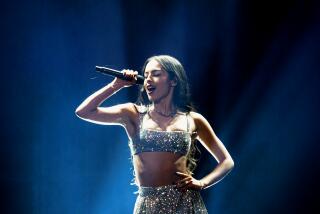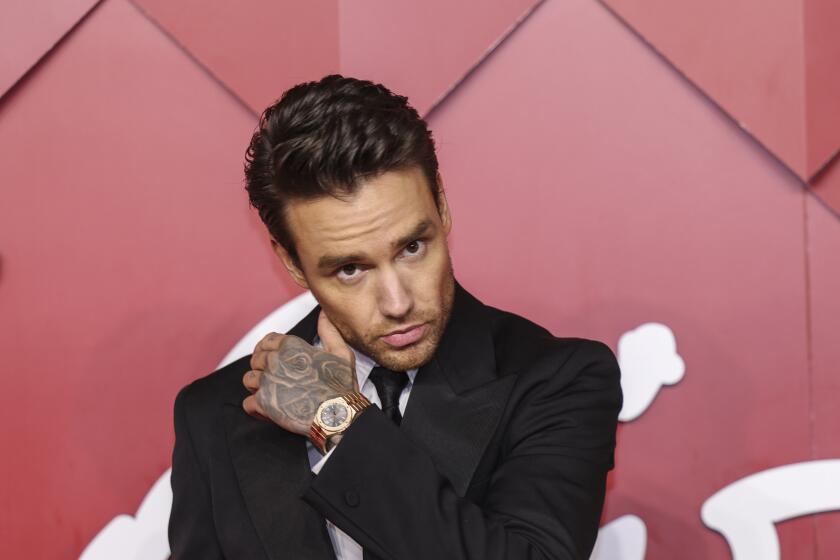Review: Kesha’s powerful Rainbow tour celebrated a pop survivor
The roar of support from a sold-out crowd at the Hollywood Palladium was proof enough: The past year of reckoning for sexual predators has a soundtrack, and it’s Kesha’s “Rainbow.”
On the last stop of the singer’s North American Rainbow tour Wednesday, grown men with glitter warpaint streaked across their cheeks, teens in “Nasty Woman” T-shirts and celebrities who braved the hoi polloi cheered for a pop star who in any other era would have been destroyed for speaking out against a powerful man who once steered her career.
The platinum-selling “Tik Tok” singer’s momentum came to an abrupt halt in 2014 when she expressed frustration over her lack of creative control and sought to break her recording contract with superstar producer Dr. Luke, the career maker and label owner who discovered her as a teen.
Her ensuing allegations of sexual, physical, verbal and emotional abuse, including two instances in which she claimed he drugged and raped her, became fodder for social media campaigns and petitions to “Free Kesha.” He denied all the claims and counter-sued. She lost numerous appeals and is still signed to the label he founded (Dr. Luke is no longer its chief executive).
But Kesha, now 30, won in the court of public appeal, amassing an army of supporters that include Taylor Swift. The outcry undoubtedly played a role in Dr. Luke ceding artistic control to the singer. Her bittersweet victory underpinned a movement of women (and men) coming forward with their sexual misconduct allegations against other powerful figures. Hollywood mogul Harvey Weinstein and talk-show host Bill O’Reilly are the most prominent media giants to fall over the past year.
Wednesday marked the L.A. stop of Kesha’s first US tour in nearly five years, an eternity in the manic spin cycle of the pop world, where an absence from the spotlight for even a few months can equal career peril or extinction.
She opened her 90-minute show with three words: “We did it!”
Fans sang aloud passionately to new songs off “Rainbow” that indirectly address her recent struggles (“You brought the flames and you put me through hell / I had to learn how to fight for myself / And we both know all the truth I could tell / I’ll just say this is I wish you farewell”) and numbers that celebrate her newfound independence (“Don’t buy me a drink, I make my money / Don’t touch my weave, don’t call me honey, ‘Cause I run my [stuff], baby.”)
Dressed in a sequined, black pantsuit and with her waist-length blond locks flowing behind her like a superhero cape, she belted out the numbers with confidence and conviction.
Kesha’s past performances on tours for her “Animal” and “Warrior” albums were always high-energy (if not absurdly raucous) affairs but were more about exuding a rebel party spirit than a personal strength.
Flanked by two waifish, male dancers, Kesha strutted across the stage as they playfully gyrated, go-go danced and fawned by her side. Her five-piece band performed faithful versions of her songs off “Rainbow” — tunes that are a mix of rock, country, dance and singer-songwriter confessionals.
She brought out her mother, Pebe Sebert, for one of the many tracks they’ve co-written, “Godzilla.” But before they started the song, Pebe thanked the audience for supporting her daughter through such difficult times.
The only other guest was Eagles of Death Metal frontman Jesse Hughes, who performed “Let ‘Em Talk” with Kesha. It was a fun and then-moving moment from a fellow performer whose been fighting to overcome a different challenge — the deadly 2015 terror attack at Paris’s Bataclan concert venue while he performed with his band.
At the Palladium the two singers belted the pop-punk song while dancing together like post-modern versions of Olivia Newton-John and John Travolta in the finale of “Grease.”
During breaks between numbers, the audience took the chance to commandeer the show from the floor. Young women, many of whom emulated the new Kesha’s Janis Joplin-inspired styling of floppy hats and flowing yet scrappy hippie garb, and male couples who embraced during her set, broke out into a venue-wide chant: “Kesha, Kesha, Kesha.” The singer stood arms open wide, head titled back, as if she were basking in the glow of the sun. Loyalty personified.
The audience’s interest and energy did flag at points, but it was in the most unlikely spots, at least for a pop show. Her biggest hits got the smallest reaction. When Kesha performed the dance-pop singles that made her a star — “Timber,” “Tik Tok” — her delivery and the response was markedly less passionate. And at points, she and the band were too loose and un-orchestrated to pull those numbers off.
It was partly because those songs were made to be played at clubs and in arenas, accompanied by a choreographed laser light show, multiple sound-enhancing backing tracks and the high-pitched screams of a billion teen fans. Her post-“Rainbow” renditions were less bombastic.
But it was also what those songs represented: a young singer, paired with a much older producer, catering to a market that chews up and spits out developing singers like baseball players do chewing tobacco (the World Series had to factor in here somewhere given that it was happening mere miles away from Kesha’s show).
That doesn’t mean those older songs weren’t top-tier party fodder — many of them were — but they don’t represent the singer anymore, or the moment she now represents.
More to Read
The biggest entertainment stories
Get our big stories about Hollywood, film, television, music, arts, culture and more right in your inbox as soon as they publish.
You may occasionally receive promotional content from the Los Angeles Times.











